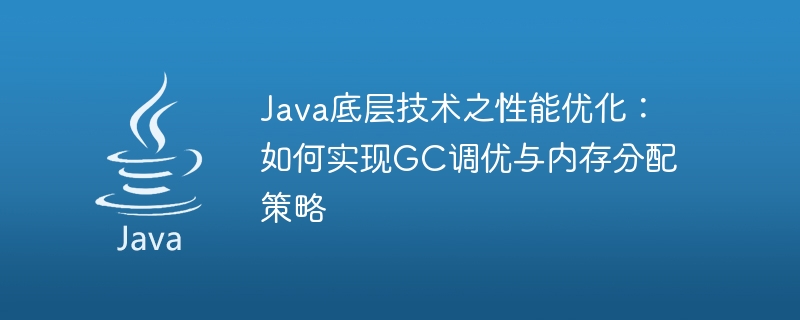Home >Java >javaTutorial >Performance optimization of Java underlying technology: how to implement GC tuning and memory allocation strategies
Performance optimization of Java underlying technology: how to implement GC tuning and memory allocation strategies
- WBOYWBOYWBOYWBOYWBOYWBOYWBOYWBOYWBOYWBOYWBOYWBOYWBOriginal
- 2023-11-08 13:37:461483browse

Java is one of the most widely used programming languages, and the underlying technology of the Java language is crucial to program performance optimization. In this article, we will focus on performance optimization of Java's underlying technology, including how to implement GC tuning and memory allocation strategies, and provide specific code examples.
- GC Tuning
The Java language uses an automatic memory management mechanism, namely the garbage collection (Garbage Collection, GC) mechanism. The GC mechanism can automatically reclaim memory that is no longer in use and release it to applications for reuse. However, due to the uncontrollability of the GC mechanism and the consumption of executable resources, some problems and challenges may occur in systems with high concurrency, large amounts of data, and long-running systems, such as frequent Full GC and excessively long STW ( Stop the world) time, etc. Therefore, GC tuning is an important part of Java program optimization.
1.1 GC algorithm
The GC algorithm is the core mechanism that determines how the JVM performs garbage collection operations. The JVM uses a variety of GC algorithms, including mark-sweep algorithms, copy algorithms, mark-collation algorithms, generational collection algorithms, etc. Different GC algorithms are suitable for different scenarios. In actual development, we should choose an appropriate GC algorithm to ensure garbage collection efficiency while minimizing the impact on the application.
1.2 GC parameter tuning
The JVM provides a series of GC parameters through which developers can adjust the behavior of the garbage collection mechanism to optimize application performance. Some commonly used GC parameters include:
- -XX: PrintGC: Print GC log
- -XX: PrintGCDetails: Print GC details
- -XX: PrintGCDateStamps : Print the timestamp when GC occurred
- -XX: UseSerialGC: Use the serial GC algorithm
- -XX: UseParallelGC: Use the parallel GC algorithm
- -XX: UseConcMarkSweepGC: Use CMS GC algorithm
- -Xms: Initial heap size
- -Xmx: Maximum heap size
In actual applications, we need to combine specific application scenarios and hardware configuration to adjust GC parameters.
1.3 GC log analysis
For GC tuning, GC log is a very important tool. The GC log records detailed information about the JVM's garbage collection and can help us diagnose GC behavior and performance problems. In the GC log, we can view information such as the time when GC occurred, type, time taken, and how much memory was recycled. By analyzing GC logs, you can locate bottlenecks and problems that consume performance during GC operation, and make corresponding adjustments.
The following is a sample GC log:
2019-07-01T11:06:03.837+0800: 1.012: [GC (Allocation Failure) [PSYoungGen: 335544K->52432K(392192K)] 335544K->94764K(1179648K), 0.4857061 secs] [Times: user=0.66 sys=0.01, real=0.49 secs]
As you can see, this is a young generation GC. The timestamp of GC is 2019-07-01T11:06:03.837 0800, which consumes It lasted 0.49 seconds, and 52432K memory space was collected in this GC.
- Memory allocation strategy
In addition to GC tuning, another commonly used optimization method is memory allocation strategy. The memory allocation strategy can be set through parameters when the program starts, and specifies how the JVM allocates memory to adapt to different application scenarios. Reasonable settings of the memory allocation strategy can effectively eliminate memory fragmentation, reduce the frequency of GC, and improve the operating efficiency of the application.
2.1 The size of the object
In the memory allocation strategy, the first issue to consider is the size of the object. The size of an object can usually be calculated by the following two methods:
- Actual measurement method: Use the tools provided by the JVM to calculate the memory space occupied by an object.
- Estimation method: By analyzing the object's data structure and the number of member variables, we can roughly estimate the memory space occupied by the object.
2.2 Object life cycle
In the memory allocation strategy, the life cycle of the object also needs to be considered, including the creation time, usage time and destruction time of the object. Reasonably and accurately estimating the life cycle of objects can help us perform memory management reasonably and accurately to achieve the purpose of optimizing applications.
2.3 Memory allocation algorithm
In Java, memory allocation algorithms usually include the following:
- Pointer collision (Bump the Pointer) algorithm: used for continuous Memory allocation.
- Free List algorithm: used for discrete memory allocation.
- Thread-Local Allocation Buffer (TLAB) algorithm: used for thread-specific memory allocation, which can avoid thread synchronization overhead when multi-threads allocate objects.
2.4 Setting of memory allocation parameters
In Java, memory allocation parameters can be set through the following parameters:
- -Xms: Initial heap size
- -Xmx: Maximum heap size
- -XX: NewSize: Initial size of the new generation
- -XX: MaxNewSize: Maximum size of the new generation
- -XX :SurvivorRatio: The size ratio between the Eden area and the Survivor area
- -XX:PretenureSizeThreshold: When the object is larger than this value, it is directly allocated to the old generation
In actual applications, we should Set the memory allocation parameters according to the characteristics and needs of the application, combined with the hardware configuration and load conditions.
The following is an example of a simple memory allocation strategy:
public class MemAllocPerformance {
private static final int LOOP_COUNT = 10000000;
private static final int SIZE = 256;
public static void main(String[] args) throws InterruptedException {
long start = System.currentTimeMillis();
for (int i = 0; i < LOOP_COUNT; i++) {
// 方式一:使用new关键字创建对象
Object obj = new Object();
// 方式二:使用对象池技术
// Object obj = ObjectPool.getInstance().getObject();
// 方式三:使用ThreadLocal技术
// Object obj = ThreadLocalObjectPool.getInstance().getObject();
// 模拟对象使用
byte[] data = new byte[SIZE];
}
long end = System.currentTimeMillis();
System.out.println("Time cost: " + (end - start) + "ms");
}
}在以上代码中,我们使用了三种不同的内存分配策略,分别是new方式、对象池技术和ThreadLocal技术。new方式是最简单常见的对象创建方式,而对象池技术和ThreadLocal技术则可以充分利用Java内存分配特性,避免过多的内存分配和回收,从而提高程序的性能表现。
总结
Java底层技术之性能优化是Java程序员的一项重要技能。在本文中,我们介绍了GC调优和内存分配策略两种优化方式,并提供了一些具体的代码示例。在实际的开发中,我们应该根据应用程序的特点和需求,综合考虑硬件的配置和负载情况,选取和调整合适的GC算法和内存分配策略,以达到优化应用程序性能的目的。
The above is the detailed content of Performance optimization of Java underlying technology: how to implement GC tuning and memory allocation strategies. For more information, please follow other related articles on the PHP Chinese website!

